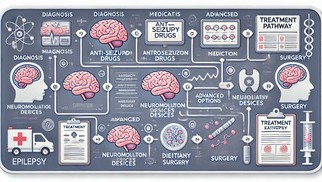Epilepsy Treatment in Children and Adults


Epilepsy is a neurological disorder characterized by recurring, unprovoked seizures. Affecting individuals of all ages, epilepsy requires tailored treatment approaches depending on the patient’s age, type of seizure, and underlying cause. This article examines how epilepsy is treated in children and adults, key differences in the condition’s manifestation between these groups, emerging therapies, medication options like Keppra (Levetiracetam), and the natural history and prognosis of the disorder.
How Do You Treat Epilepsy in Children?
Treating epilepsy in children involves balancing effective seizure control with minimal side effects, ensuring the child’s cognitive and social development is not hindered. Common treatment modalities include:
- Anti-Seizure Medications (ASMs): ASMs are the first-line therapy for most pediatric epilepsy cases. Drugs like levetiracetam, valproic acid, and lamotrigine are prescribed based on seizure type and age. Treatment typically starts with low doses, gradually increased to achieve seizure control while monitoring for side effects like fatigue and mood changes.
- Ketogenic Diet: A high-fat, low-carbohydrate diet, the ketogenic diet alters the brain’s metabolism and significantly reduces seizure frequency in many children with drug-resistant epilepsy. However, it requires close medical and nutritional supervision to avoid side effects such as nutritional deficiencies.
- Surgery and Neuromodulation: For children whose seizures remain uncontrolled by medication or diet, options like lobectomy or vagus nerve stimulation (VNS) may be considered. Neuromodulation therapies like responsive neurostimulation (RNS) are gaining popularity as minimally invasive alternatives. By incorporating comprehensive medical care and social support, pediatric epilepsy treatment ensures a balance between seizure control and quality of life.
How Is Epilepsy Different in Children Compared to Adults?
Although epilepsy shares core characteristics across age groups, it differs significantly between children and adults due to biological and developmental factors:
- Seizure Types: Children are more likely to experience unique seizure types such as infantile spasms or absence seizures, while adults often present with focal seizures or generalized tonic-clonic seizures.
- Causes: Genetic factors and congenital brain abnormalities are more prevalent causes of epilepsy in children, while in adults, it is often triggered by acquired conditions like trauma or stroke.
- Impact: In children, epilepsy can disrupt learning and social development, requiring added academic and behavioral support. Adults face challenges like work limitations or driving restrictions, requiring workplace accommodations and counseling.
Understanding these differences is essential to developing age-appropriate treatment strategies that address specific needs effectively.
Treatment with Medication: Keppra (Levetiracetam)
Keppra (Levetiracetam) is a widely used antiepileptic drug effective in managing various seizure types, making it a cornerstone of treatment for both children and adults.
How Keppra Works
Keppra stabilizes electrical activity in the brain, reducing seizure likelihood. Its primary mechanism is believed to involve binding to the synaptic vesicle protein 2A, which regulates neurotransmitter release. This unique action allows it to control seizures effectively while maintaining a favorable safety profile.
Benefits of Keppra
- Broad Efficacy: Effective against focal, myoclonic, and generalized tonic-clonic seizures.
- Minimal Interactions: Its lack of significant drug interactions makes it a preferred choice, particularly for individuals on multiple medications.
- Flexibility: Keppra is available in liquid form for children and weight-adjusted dosing allows for customized treatment.
Use in Children and Adults
- Children: Keppra is approved for use in children as young as one month old and is commonly prescribed due to its ease of administration and favorable safety profile.
- Adults: In adults, Keppra is effective both as a monotherapy and in combination with other drugs, particularly in cases of drug-resistant epilepsy.
While Keppra is generally well-tolerated, some patients may experience mood changes or drowsiness, requiring careful monitoring by healthcare providers.
What Are the New Treatments for Children with Epilepsy?
Innovations in pediatric epilepsy treatment are providing new hope for children and their families:
- Genetic Therapies: Advances in genomic medicine enable targeted treatments for specific conditions like Dravet syndrome using therapies like antisense oligonucleotides.
- Cannabidiol (CBD)-Based Therapies: Medications like Epidiolex offer significant seizure reduction, particularly for syndromes like Lennox-Gastaut and Dravet.
- Refined Diets: Modified ketogenic diets, such as the Atkins variant, provide greater flexibility while maintaining effectiveness.
- Novel Neuromodulation: Devices like transcranial magnetic stimulation (TMS) and adaptive neurostimulation are showing promise in research trials.
These emerging therapies are expanding options for pediatric patients with complex or treatment-resistant epilepsy.
The Natural History and Prognosis of Epilepsy
Disease Progression
The course of epilepsy varies widely depending on factors like the type of seizure and the underlying cause:
- Children: Many childhood epilepsies, such as childhood absence epilepsy, resolve by adolescence, while conditions like Lennox-Gastaut syndrome often persist into adulthood.
- Adults: Epilepsy triggered by trauma or neurodegenerative conditions may show a chronic progression.
Outcomes and Treatment Resistance
While approximately two-thirds of people with epilepsy achieve seizure freedom with proper treatment, around one-third experience drug-resistant epilepsy, requiring additional interventions like surgery or neuromodulation.Quality of Life Considerations Epilepsy’s impact goes beyond medical symptoms, affecting education, employment, and mental health. Addressing stigma and providing psychological support is critical to improving patients’ overall quality of life.
Conclusion
Epilepsy treatment in children and adults requires a nuanced approach, tailored to the unique needs of each age group. Pediatric epilepsy focuses on minimizing developmental disruption, while adult treatment often addresses acquired causes and long-term management. Medications like Keppra play a key role, offering broad-spectrum efficacy and flexibility, while emerging therapies such as genetic medicine and CBD-based treatments bring new possibilities for seizure control. A thorough understanding of the natural history of epilepsy and the availability of comprehensive support systems ensure better outcomes for individuals living with this complex condition. With ongoing advancements, the future of epilepsy care looks increasingly optimistic.
Article post: Editorial Team of RXShop.md
(Updated at Jan 6 / 2025)
Keppra Levetiracetam articles:
Some of the trademarks used in this Web Site appear for identification purposes only.
All orders are reviewed by a licensed physician and pharmacist before being dispensed and shipped.
The statements contained herein are not intended to diagnose, treat, cure or prevent disease. The statements are for informational purposes only and is it not meant to replace the services or recommendations of a physician or qualified health care practitioner. If you have questions about the drugs you are taking, check with your doctor, nurse, or pharmacist.

